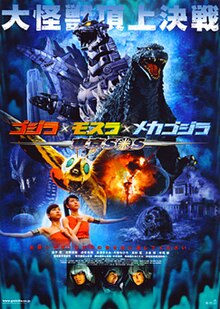Godzilla: Tokyo SOS
| Godzilla: Tokyo S.O.S. | |
|---|---|

Japanese theatrical release poster
|
|
| Directed by | Masaaki Tezuka |
| Produced by | Shogo Tomiyama |
| Written by | Masaaki Tezuka Masahiro Yokotani |
| Starring |
Noboru Kaneko Miho Yoshioka Mitsuki Koga Hiroshi Koizumi |
| Music by | Michiru Ôshima |
| Cinematography | Yoshinori Sekiguchi |
|
Production
company |
|
| Distributed by | Toho |
|
Release date
|
|
|
Running time
|
91 minutes |
| Country | Japan |
| Language | Japanese |
| Box office | US $12 million |
Godzilla: Tokyo S.O.S. (ゴジラ×モスラ×メカゴジラ 東京SOS? Gojira Mosura Mekagojira Tōkyō Esu Ō Esu, released in Japan as Godzilla X Mothra X Mechagodzilla: Tokyo SOS) is a 2003 Japanese science fiction tokusatsu kaiju film featuring Godzilla, produced and distributed by Toho. It is the 28th film in the Godzilla franchise, the 27th Godzilla film produced by Toho, and the fifth film in the Millennium series. The film directed by Masaaki Tezuka and serves as a direct sequel to Godzilla Against Mechagodzilla. Like its predecessor, the film is in continuity with past films such as Mothra and Godzilla.
Kiryu is undergoing repair modifications after its battle with Godzilla. Prime Minister Hayato Igarashi accepts Lead Scientist Yoshito Chujo's choice to replace the Absolute Zero Cannon with a powerful Tri-Maser.
The Shobijin (Mothra's twin fairies) warn the Japanese government that Godzilla continues returning to Japan because they used the original Godzilla's bones in Kiryu's design. If they return the bones to the bottom of the sea, Mothra would gladly take Kiryu's place in defending Japan, but if they do not, Mothra will declare war on humanity. Soon enough, Kamoebas, a giant mata mata turtle, is found washed ashore on a Japanese beach. It is determined by the wounds on Kamoebas' neck that Godzilla killed it. Godzilla and Mothra fight, but Godzilla seems to have the upper hand. With the repairs finished just in time, Kiryu manages to even the odds, but Godzilla still manages to knock it and Mothra out.
...
Wikipedia
